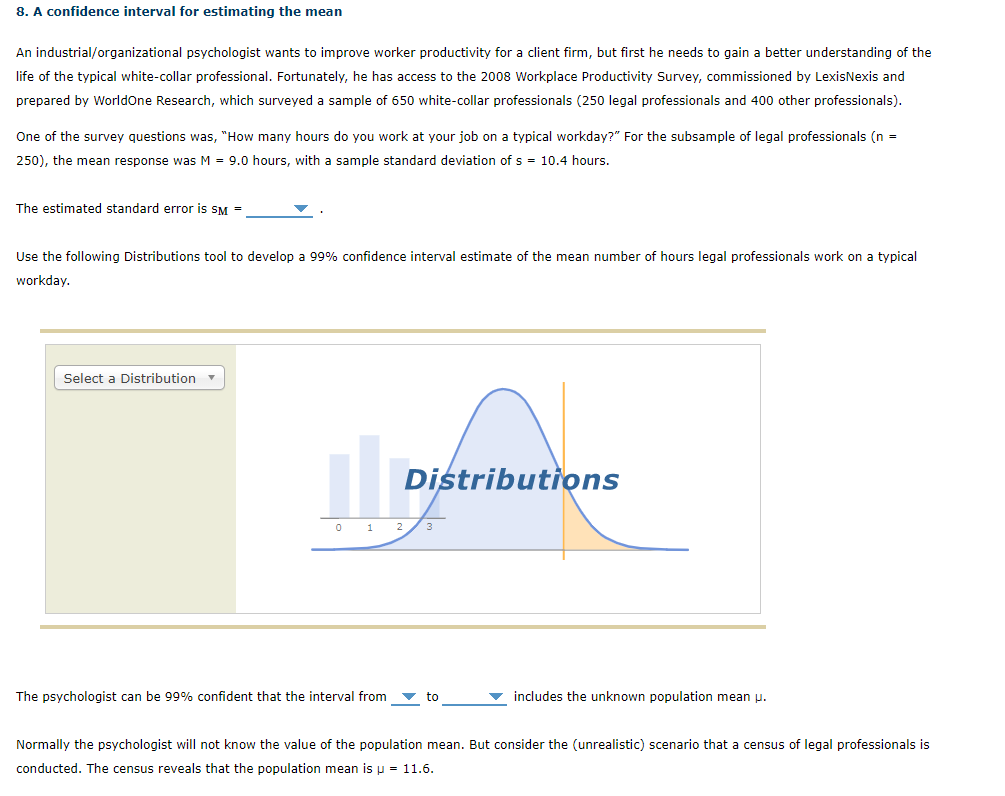8. A confidence interval for estimating the mean An industrial/organizational psychologist wants to improve worker productivity for a client firm, but first he needs to gain a better understanding of the life of the typical white-collar professional. Fortunately, he has access to the 2008 Workplace Productivity Survey, commissioned by LexisNexis and prepared by WorldOne Research, which surveyed a sample of 650 white-collar professionals (250 legal professionals and 400 other professionals). One of the survey questions was, "How many hours do you work at your job on a typical workday?" For the subsample of legal professionals (n = 250), the mean response was M = 9.0 hours, with a sample standard deviation of s = 10.4 hours. The estimated standard error is sM = Use the following Distributions tool to develop a 99% confidence interval estimate of the mean number of hours legal professionals work on a typical workday. Select a Distribution Distributions 0 1 The psychologist can be 99% confident that the interval from v to includes the unknown population mean p. Normally the psychologist will not know the value of the population mean. But consider the (unrealistic) scenario that census of legal professionals is conducted. The census reveals that the population mean is p = 11.6.
8. A confidence interval for estimating the mean An industrial/organizational psychologist wants to improve worker productivity for a client firm, but first he needs to gain a better understanding of the life of the typical white-collar professional. Fortunately, he has access to the 2008 Workplace Productivity Survey, commissioned by LexisNexis and prepared by WorldOne Research, which surveyed a sample of 650 white-collar professionals (250 legal professionals and 400 other professionals). One of the survey questions was, "How many hours do you work at your job on a typical workday?" For the subsample of legal professionals (n = 250), the mean response was M = 9.0 hours, with a sample standard deviation of s = 10.4 hours. The estimated standard error is sM = Use the following Distributions tool to develop a 99% confidence interval estimate of the mean number of hours legal professionals work on a typical workday. Select a Distribution Distributions 0 1 The psychologist can be 99% confident that the interval from v to includes the unknown population mean p. Normally the psychologist will not know the value of the population mean. But consider the (unrealistic) scenario that census of legal professionals is conducted. The census reveals that the population mean is p = 11.6.
Glencoe Algebra 1, Student Edition, 9780079039897, 0079039898, 2018
18th Edition
ISBN:9780079039897
Author:Carter
Publisher:Carter
Chapter10: Statistics
Section10.3: Measures Of Spread
Problem 1GP
Related questions
Topic Video
Question
I dont get this

Transcribed Image Text:Normally the psychologist will not know the value of the population mean. But consider the (unrealistic) scenario that a census of legal professionals is
conducted. The census reveals that the population mean is p = 11.6.
How would the psychologist most likely react to the news?
O The psychologist would be surprised that p = 11.6, because that value is inside the confidence interval.
O The psychologist would not be surprised that u = 11.6, because that value is outside the confidence interval.
O The psychologist would be surprised that p = 11.6, because that value is outside the confidence interval.
O The psychologist would not be surprised that u = 11.6, because that value is inside the confidence interval.

Transcribed Image Text:8. A confidence interval for estimating the mean
An industrial/organizational psychologist wants to improve worker productivity for a client firm, but first he needs to gain a better understanding of the
life of the typical white-collar professional. Fortunately, he has access to the 2008 Workplace Productivity Survey, commissioned by LexisNexis and
prepared by WorldOne Research, which surveyed a sample of 650 white-collar professionals (250 legal professionals and 400 other professionals).
One of the survey questions was, "How many hours do you work at your job on a typical workday?" For the subsample of legal professionals (n =
250), the mean response was M = 9.0 hours, with a sample standard deviation of s = 10.4 hours.
The estimated standard error is SM =
Use the following Distributions tool to develop a 99% confidence interval estimate of the mean number of hours legal professionals work on a typical
workday.
Select a Distribution
Distributions
0 1 2/3
The psychologist can be 99% confident that the interval from
to
includes the unknown population mean p.
Normally the psychologist will not know the value of the population mean. But consider the (unrealistic) scenario that a census of legal professionals is
conducted. The census reveals that the population mean is p = 11.6.
Expert Solution
This question has been solved!
Explore an expertly crafted, step-by-step solution for a thorough understanding of key concepts.
This is a popular solution!
Trending now
This is a popular solution!
Step by step
Solved in 3 steps with 3 images

Knowledge Booster
Learn more about
Need a deep-dive on the concept behind this application? Look no further. Learn more about this topic, statistics and related others by exploring similar questions and additional content below.Recommended textbooks for you

Glencoe Algebra 1, Student Edition, 9780079039897…
Algebra
ISBN:
9780079039897
Author:
Carter
Publisher:
McGraw Hill

Glencoe Algebra 1, Student Edition, 9780079039897…
Algebra
ISBN:
9780079039897
Author:
Carter
Publisher:
McGraw Hill